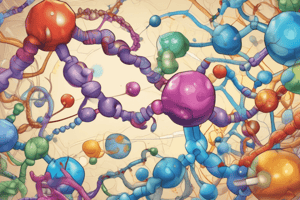Podcast
Questions and Answers
What do simple proteins produce upon hydrolysis?
What do simple proteins produce upon hydrolysis?
- Only amino acids (correct)
- Non-protein compounds
- Amino acids and fatty acids
- Polypeptides and amino acids
What distinguishes compound proteins from simple proteins?
What distinguishes compound proteins from simple proteins?
- Compound proteins contain amino acids only
- Compound proteins do not contain any non-protein parts
- Compound proteins produce multiple types of amino acids upon hydrolysis
- Compound proteins consist of protein and non-protein components (correct)
What are derived proteins primarily formed from?
What are derived proteins primarily formed from?
- Compound proteins only
- Degraded simple and compound proteins (correct)
- Simple proteins only
- Only non-protein sources
Which statement about simple and compound proteins is accurate?
Which statement about simple and compound proteins is accurate?
Which substance does NOT have a known binding site mentioned?
Which substance does NOT have a known binding site mentioned?
During hydrolysis, what would NOT be a product of simple proteins?
During hydrolysis, what would NOT be a product of simple proteins?
What is a common feature of both Zein of corn and Glutenin?
What is a common feature of both Zein of corn and Glutenin?
Which of the following is incorrectly associated?
Which of the following is incorrectly associated?
Which of the following pairs correctly describes a characteristic relationship?
Which of the following pairs correctly describes a characteristic relationship?
Which binding site is specifically related to a dairy product?
Which binding site is specifically related to a dairy product?
What role does acid play in the human body?
What role does acid play in the human body?
Which of the following statements about acid in plants is true?
Which of the following statements about acid in plants is true?
Which of the following is a source of acid that is considered deficient in certain crops?
Which of the following is a source of acid that is considered deficient in certain crops?
Which option represents a function of acid in salmon?
Which option represents a function of acid in salmon?
Which statement about the presence of acid in hemoglobin is accurate?
Which statement about the presence of acid in hemoglobin is accurate?
Which component is primarily classified as a main protein associated with cholesterol transport?
Which component is primarily classified as a main protein associated with cholesterol transport?
Which of the following proteins is formed in association with zinc?
Which of the following proteins is formed in association with zinc?
Which type of proteins involve a metal cofactor in their structure?
Which type of proteins involve a metal cofactor in their structure?
What role do antibodies play in the immune response?
What role do antibodies play in the immune response?
Which lipoprotein is primarily associated with the transport of triglycerides in the blood?
Which lipoprotein is primarily associated with the transport of triglycerides in the blood?
What role does ferritin primarily serve in the body?
What role does ferritin primarily serve in the body?
Which vitamin is associated with forming cofactors like FAD and FMN?
Which vitamin is associated with forming cofactors like FAD and FMN?
Which structural characteristic of proteins helps them transport lipids in blood?
Which structural characteristic of proteins helps them transport lipids in blood?
What is the primary characteristic of mucin found in the gastrointestinal tract?
What is the primary characteristic of mucin found in the gastrointestinal tract?
Which component is not directly involved in protein synthesis?
Which component is not directly involved in protein synthesis?
Flashcards are hidden until you start studying
Study Notes
Protein Types
- Simple proteins: Hydrolyze into only amino acids.
- Compound proteins: Consist of a protein part and a non-protein part.
- Derived proteins: Formed from the breakdown of simple or compound proteins.
Compound Protein Examples
- Nucleoproteins: Bind to nucleic acid, with supportive and protective functions.
- Found in human body, milk, muscle, and salmon.
- Examples include hemoglobin (main protein in blood), insulin, antibodies, LDL, HDL, ribosomes, and ferritin (iron storage protein).
- Phosphoproteins: Protein + phosphoric acid.
- Examples include casein (milk protein) and glutenin (wheat protein).
- Flavo-proteins: Protein + FAD or FMN (yellow color).
- FAD/FMN is attached to the protein via the OH group.
- Responsible for lipid transport in blood.
- Glycoproteins: Protein + carbohydrate.
- Examples include blood group antigens, mucin (in the gastrointestinal tract), and zein (corn protein).
Noteworthy Points
- Zein: Found in maize but deficient in certain amino acids.
- Glutenin: Found in wheat.
- Casein: Found in milk.
- Lactalbumin: Found in milk, along with zinc.
Studying That Suits You
Use AI to generate personalized quizzes and flashcards to suit your learning preferences.




